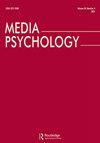具体动机:虚拟现实中接近和回避的时空方面
IF 2.6
2区 心理学
Q1 COMMUNICATION
引用次数: 3
摘要
摘要:本研究探讨了虚拟现实(VR)中物体可视性如何调节接近和回避行为。主要假设是:1)动机相关性在与虚拟物体互动时形成行为的促进或抑制;2)方法回避可以使用虚拟现实中行为的空间和时间方面进行量化。在使用不同效价和唤醒水平的图像进行虚拟照片分类任务时,进行了一项实验来跟踪和检查用户的行为。在任务过程中,接近和回避的空间指标被操作为个体与照片之间的距离。时间指标包括凝视物体的速度和延迟、选择顺序和排序行为。结果表明,刺激效价和唤醒显著影响对象选择的速度和延迟,表明对虚拟对象的动机反应。探索性分析还揭示了个体之间不同的对象选择模式。总体而言,本研究对虚拟环境的设计具有启示意义,并支持使用VR技术研究与媒体心理学家相关的动机过程和行为。本文章由计算机程序翻译,如有差异,请以英文原文为准。
Embodied Motivation: Spatial and Temporal Aspects of Approach and Avoidance in Virtual Reality
ABSTRACT This study investigates how object affordances modulate approach and avoidance behaviors in virtual reality (VR). The primary hypotheses are that 1) motivational relevance shapes facilitation or inhibition of behaviors while interacting with virtual objects, and that 2) approach-avoidance can be quantified using spatial and temporal aspects of behavior in VR. An experiment was conducted to track and examine user behaviors during a virtual photo-sorting task that used images with varying valence and arousal levels. Spatial indicators of approach and avoidance were operationalized as the distance between the individual and the photo during the task. Temporal indicators were operationalized as the speed and latency of gazing at the objects, selection order, and sorting behavior. Results show that stimulus valence and arousal significantly affect speed and latency during object selection, demonstrating motivational reactions to virtual objects. Exploratory analyses also revealed varying patterns of object selection across individuals. Overall, this study has implications for the design of virtual environments and supports the use of VR technology in studying motivational processes and behaviors relevant for media psychologists.
求助全文
通过发布文献求助,成功后即可免费获取论文全文。
去求助
来源期刊

Media Psychology
Multiple-
CiteScore
8.60
自引率
7.10%
发文量
30
期刊介绍:
Media Psychology is an interdisciplinary journal devoted to publishing theoretically-oriented empirical research that is at the intersection of psychology and media communication. These topics include media uses, processes, and effects. Such research is already well represented in mainstream journals in psychology and communication, but its publication is dispersed across many sources. Therefore, scholars working on common issues and problems in various disciplines often cannot fully utilize the contributions of kindred spirits in cognate disciplines.
 求助内容:
求助内容: 应助结果提醒方式:
应助结果提醒方式:


